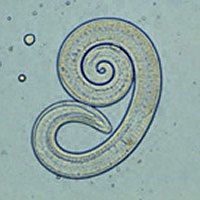
Photo from wikipedia
The aim of the present study was to evaluate the detection of trichinellosis using ELISA, and to determine the degree of variation of IgG antibodies against excretory-secretory (E-S) antigens of… Click to show full abstract
The aim of the present study was to evaluate the detection of trichinellosis using ELISA, and to determine the degree of variation of IgG antibodies against excretory-secretory (E-S) antigens of T. spiralis muscle larvae. Ten young Polish Large White native breed pigs were experimentally inoculated with a low dose of 300 invasive Trichinella spiralis (T. spiralis) muscle larvae (ML). Pig sera were collected at 7 and 9 days prior to the experimental infection with T. spiralis and at 9, 14, 20, 23, 25, 27, 30, 33, 37, 41 and 46 days post-infection (d.p.i.). Western blotting was used as a follow-up test to detect anti-T. spiralis IgG and confirm the results provided by ELISA. The molecular weight of the E-S antigenic proteins of T. spiralis muscle larvae reacting with the sera from the infected pigs was determined. Finally, the intensity of T. spiralis infection (lpg) was determined as an average value of 16 muscles taken from each pig. The E-S antigen of T. spiralis muscle larvae in the in-house ELISA and immunoblotting assays did not demonstrate any cross-reaction with non-infected pig sera and sera from pigs naturally infected with Oesophagostomum spp. The ELISA assay did not recognize trichinellosis in pigs until 27 days after the T. spiralis infection. The anti-Trichinella IgG antibodies were first detected on day 30 post-infection. The immunoblotting technique confirmed the presence of anti-Trichinella IgG antibodies in all serum samples evaluated as ELISA-positive. The Western blot detected anti-Trichinella IgG antibodies on the same day they were detected for the first time by ELISA in five pigs, whereas the immunoblot assay detected seroconversion 2, 3 or 4 days earlier than ELISA in the remaining three pigs. The swine sera reacted with a broad range of T. spiralis ML E-S antigens with molecular weights ranging from 30 to 88 kDa and the most frequently recognized proteins were 45, 49 and 60 kDa.
Journal Title: Veterinary immunology and immunopathology
Year Published: 2018
Link to full text (if available)
Share on Social Media: Sign Up to like & get
recommendations!